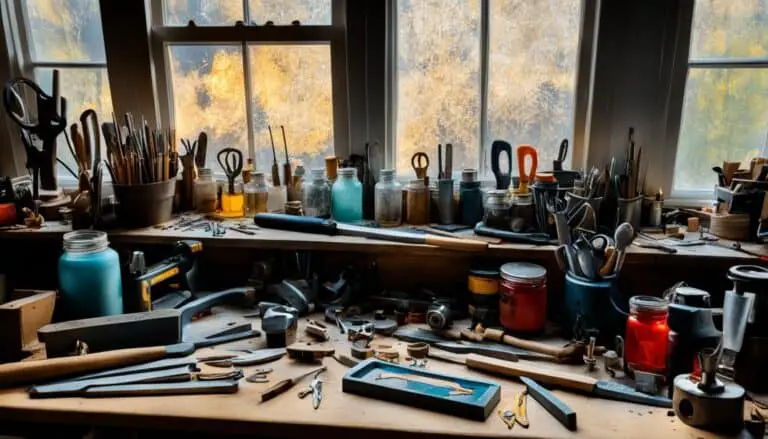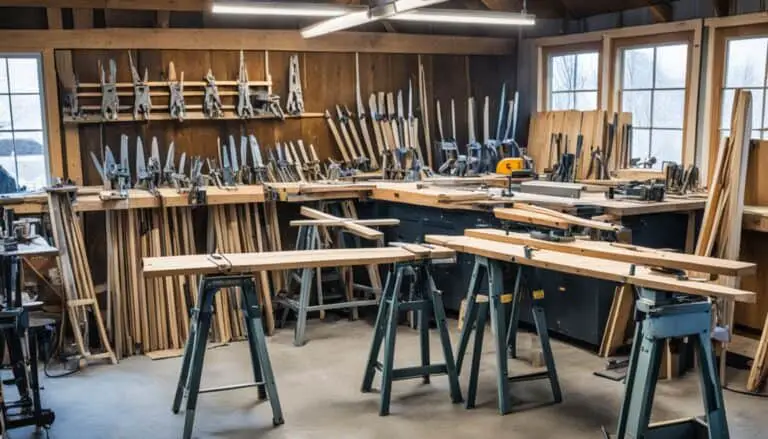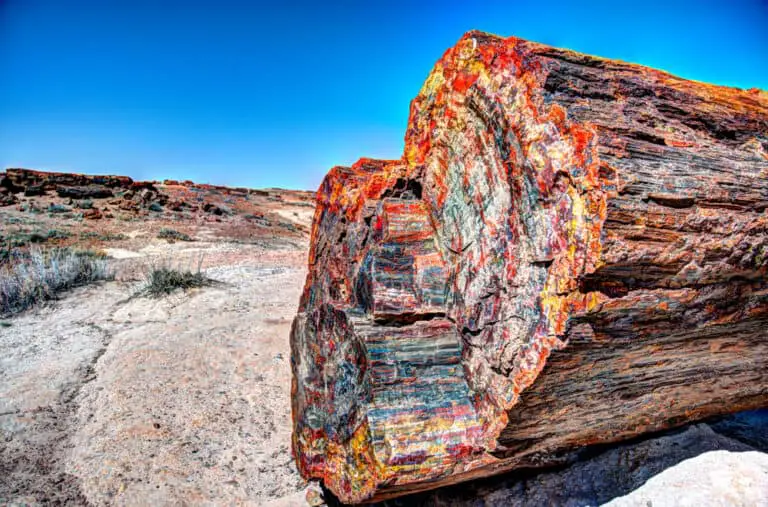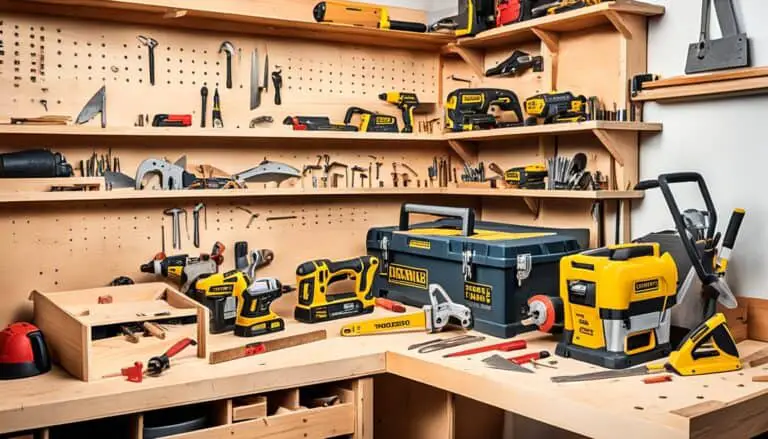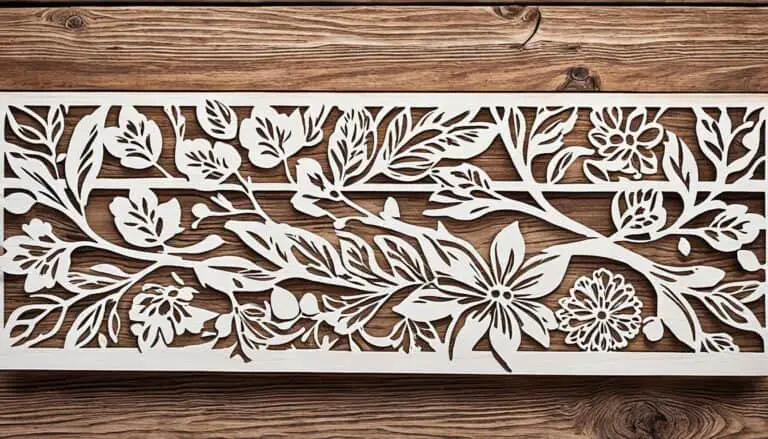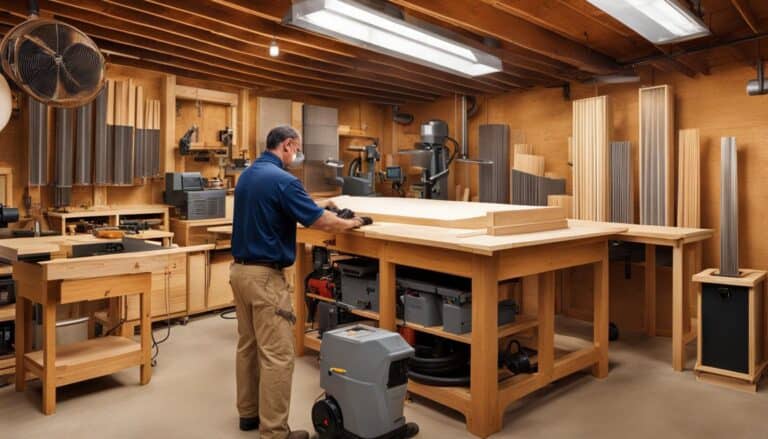Choosing the right material for your outdoor sign is key. Are you looking for something that withstands weather and looks great? Picking the correct wood for outdoor sign use is crucial for your sign’s life. It affects both the look and durability of your message. Using it for business or personal space, finding durable outdoor sign materials is essential. Woods like acacia and maple are top picks. They resist moisture and keep looking beautiful over time. Learn how to choose wood that’s both stylish and strong for your outdoor signage solutions.
Some might consider MDF or particleboard because they’re cheaper. But, these materials don’t last outside. They could lead to a sign that falls apart quickly. On the other hand, choosing weather-resistant wood signs can make your message last for years. Acacia and maple aren’t just materials. They’re the protectors of your sign’s lasting impression. Discover why investing in the right wood means balancing looks and longevity.
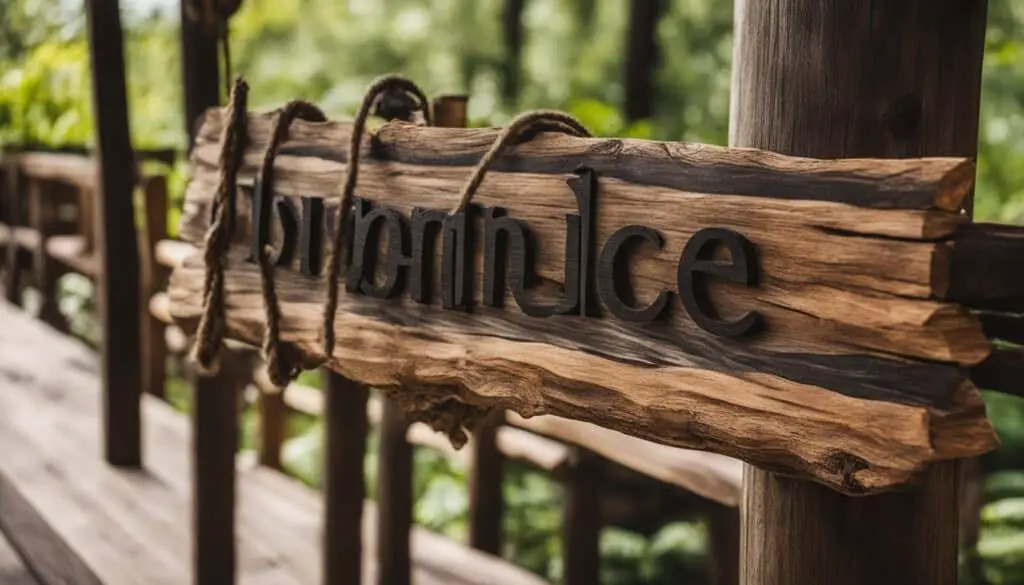
Key Takeaways
- Understand the importance of choosing the right wood to ensure both durability and aesthetic appeal for your outdoor sign.
- Learn why acacia and maple are among the top choices for weather-resistant and long-lasting displays.
- Recognize the false economy of using susceptible materials like MDF for outdoor purposes.
- Identify the essential characteristics that make wood suitable for enduring outdoor signage solutions.
- Discover how selecting the proper wood for your sign can significantly extend its lifespan and impact.
Understanding the Importance of Durable Wood for Outdoor Signs
Making weather-resistant wood signs means choosing the right wood for an outdoor sign is crucial. Signs outdoors must be durable to withstand the elements. This guide will help you pick wood that keeps your sign strong and your message clear.
The Role of Weather Resistance in Outdoor Signage Solutions
Outdoor signage solutions rely on weather resistance. Choosing wood that stands strong against rain, wind, sun, and snow means your sign will look good and stay solid for a long time. This will help it last through many seasons.
Selecting Wood Types Based on Climate Considerations
When picking the best durable outdoor sign materials, think about the climate. The wood must work well whether it’s facing ocean mists or desert winds. Here is a table to help pick the right wood for different weather conditions.
| Wood Type | Climate Suitability | Special Considerations |
|---|---|---|
| Cedar | Humid, Rainy Climates | Natural resistance to rot and insects |
| Redwood | Cool, Moist Climates | Naturally rich in tannins for decay resistance |
| ACQ-Treated Lumber | All Climates | Chemical treatment for enhanced durability, requires drying time |
| Teak | Tropical, High-Moisture Climates | Oil content provides excellent weatherproofing |
Choosing the right material is key in fighting the elements. With options like cedar and treated lumbers, your outdoor sign can face any weather. Your choice will ensure it stands strong over time.
Designing with Aesthetics: Choosing Stylish Wood for Custom Outdoor Signs
When picking the perfect wood for your outdoor wooden signs, you’ll find many options. This variety makes the process both exciting and a bit overwhelming. The beauty of customized signs is how they deliver your message and blend with their surroundings. Wood is ideal for such signs. It looks natural and can be adapted for either a classic or modern look.
Choosing the right wood type is crucial for your custom outdoor sign. For a traditional look, consider cherry or walnut. These woods are strong and have beautiful colors and patterns. They add an artistic touch. Imagine a walnut sign with your family’s name, or a cherry wood sign that attracts everyone’s attention.
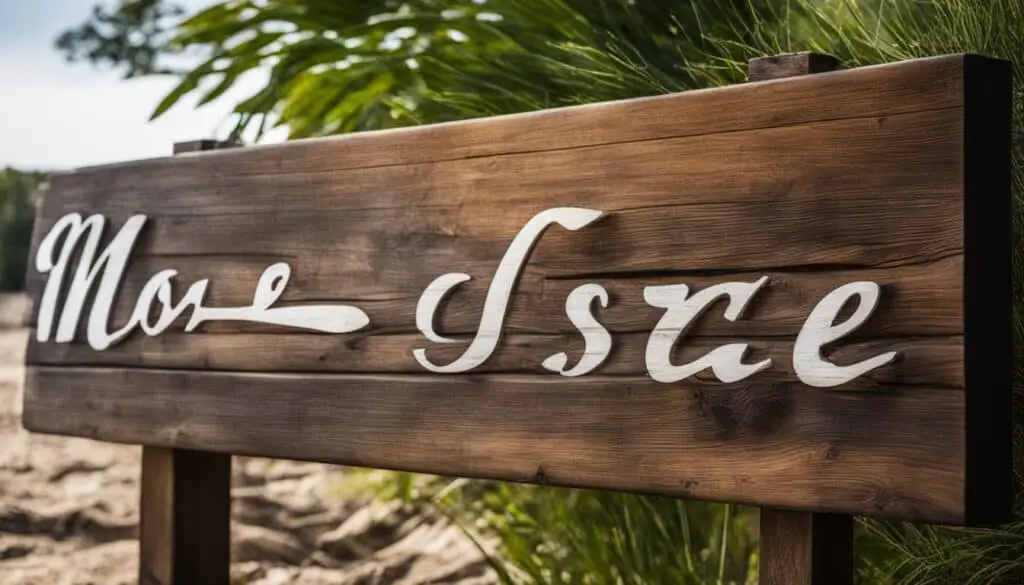
Every wood type brings a different feel to your sign, allowing you to match it to your vision perfectly. Plywood, for instance, is great for any design direction. It works well with paint and stains. So, it can look both rustic or modern, depending on your creative vision.
- Cherry Wood: Known for its reddish hue, cherry ages to a beautiful patina, full of sophistication.
- Walnut Wood: Its deep chocolate brown adds luxury to your sign.
- Plywood: Versatile and adaptable, plywood is perfect for various designs. It makes your sign both beautiful and clear.
When making wooden signs for outdoor use, the details make all the difference. It’s not just about choosing wood. It’s about how the wood looks in your space. The aim is a sign that withstands time. And one that leaves a strong impression with its timeless beauty.
Common Misconceptions About Wood for Outdoor Sign Durability
When picking durable outdoor sign materials, it’s key to clear up some myths. Not every wooden sign can handle outdoor life well. Each wood type has unique traits that determine if your sign will endure.
The Myth of One-Size-Fits-All Wood Solutions for Outdoor Use
Many think any wood works for all outdoor signs. Yet, different woods have varied durability features and looks. Some love the raw beauty of untreated wood. But, without proper care, certain woods won’t last.
Demystifying the Durability of Popular Woods like Pine and Cedar
Pine often gets misunderstood regarding outdoor use. Without a lot of care and treatment, it can warp or rot. Cedar, though, is known for fighting off insects and rot. It’s great for custom wood signs for outdoor display.
| Wood Type | Weather Resistance | Suitability for Outdoor Signs | Visual Appeal | Maintenance Needs |
|---|---|---|---|---|
| Pine | Low without treatment | Good with proper treatment and upkeep | Varies; generally light color with visible grain | High |
| Cedar | High | Excellent for outdoor use | Rich coloration with a distinct grain | Moderate |
| Redwood | High | Very suitable | Deep rich tones and smooth finish | Low to moderate |
| MDO (Medium Density Overlay) | Very high | Ideal for flat and smooth signs | Sleek, paintable surface | Low |
Pine might be common and adaptable, but it needs a lot of care to last outside. Cedar and similar durable materials fit outdoor conditions better, needing less upkeep.
Choosing wood for outdoor signs balances durability and natural style. Knowing about wood helps avoid future problems and ensures your custom wood sign for outdoor display is both beautiful and enduring.
Personalized Wooden Signage: Blending Durability with Customization
Choosing personalized wooden signage means more than getting a product. It’s about making a symbol that represents your identity or brand. These custom pieces need to last through weather without losing their unique look. The choice of wood for outdoor sign is key to durability and custom appeal.
Acacia is known for its strength in harsh weather. Its durability makes sure your custom wood signs for outdoor display stay beautiful for years. Acacia shows that practicality and personal touch can come together perfectly.
Maple is great for its smooth grain. It’s ideal for detailed designs and engravings, important for personalized signs. The options for customization are endless, from deep messages to detailed logos. Each sign is uniquely yours.
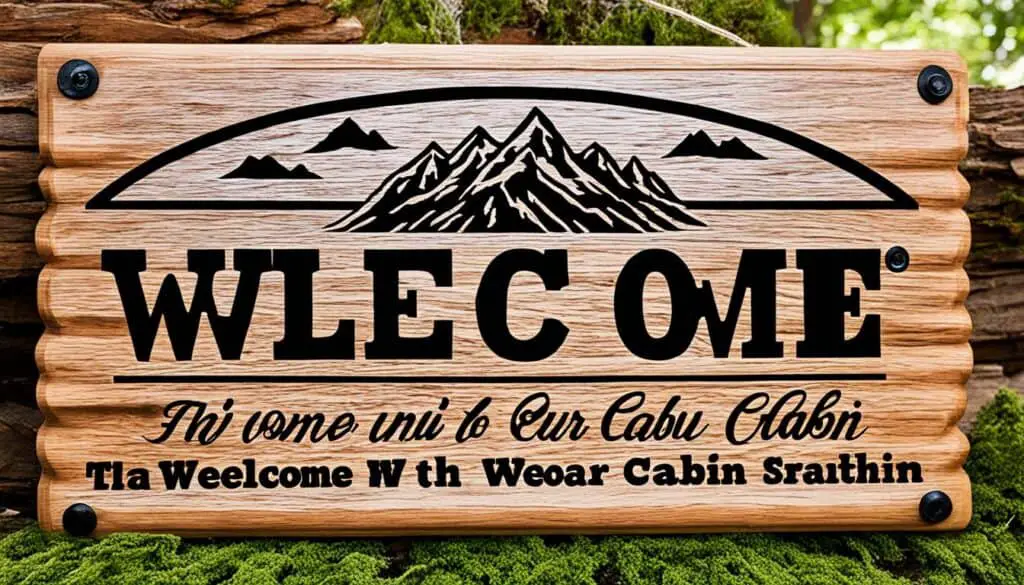
Using acacia and maple shows you value quality materials. It means you’re dedicated to making a visual statement that’s strong and unique. Signage can welcome guests or attract customers, mixing function with personal art.
Novelty and nature merge in every wood grain, creating a special canvas for your story.
Personalization goes beyond choosing wood. Painting, burning, and sealing add protection and make your signs unique. These arts make sharing information a part of your personal or business expression. It’s the blend of art and use that makes wooden signs stand out.
- Durability to withstand diverse climates with woods like acacia
- Maple’s fine grain enabling unparalleled custom details
- Varied techniques for sign customization, including painting and engraving
Making a strong first impression is crucial. Your personalized signage should show the strength and character you aim to project. Picking woods like acacia and maple ensures your signs last and tell your story as strongly as on day one.
Durable Outdoor Sign Materials: Beyond Wood Options
Wood is great for outdoor signs because it looks classic and beautiful. But, you’re not just stuck with wood. There are composite materials for outdoor signage and plastics. These options are more durable and can handle weather better than wood.
Exploring Composite and Plastic Alternatives for Outdoor Signs
Finding weather-resistant wood signs has led to new materials like composites and plastics. They’re popular because they don’t rot. This means your sign stays in good shape for a long time. These materials also don’t splinter or warp like wood can after being out in the sun, rain, and wind.
When picking composites, think about how they look. They sort of look like wood, but not exactly. They might fit your brand’s style, or maybe not. But, they’re easy to take care of. That’s a big plus for business owners and everybody else.
How High-Density Urethane Complements Wood in Signage
High-density urethane signs, or HDU, are loved by sign makers and businesses. HDU is light but very strong. It can be shaped and carved just like wood. HDU is also weatherproof, making it perfect for extreme weather or as an option instead of wood.
HDU is really good for signs with lots of details. It can be painted any color, so you can get really creative. When you’re choosing materials for your outdoor signs, think about these cool options. They’ll make sure your sign lasts a long time and keeps catching eyes.
Looking for durable and good-looking signs? Think about all your materials, including composites and high-density urethane. They’ll make your outdoor sign last and stand out.
Maintenance and Upkeep for Your Wooden Signs for Outdoor Use
Keeping wooden signs outside requires care to keep them looking good. To protect them from the weather, it’s important to pick the right finishes. We will explain how to keep your outdoor wooden signs in great shape.
The Right Finishes to Protect Your Wood Sign from the Elements
Choosing strong finishes is crucial for outdoor signs. Finishes like marine-grade varnishes and spar urethane protect against UV rays and moisture. This not only keeps the sign safe but also makes it last longer in outdoor settings. Remember to reapply these finishes regularly for the best protection.
Regular Maintenance Checklists for Longevity
Staying on top of maintenance is key for wooden signs used outdoors. Following a maintenance calendar helps avoid big problems down the line. Here’s a checklist to help your outdoor wooden sign stay in top shape:
| Maintenance Task | Description | Frequency |
|---|---|---|
| Inspect for Damage | Check the sign for any cracks, chips, and damage from rot or bugs. | Monthly |
| Clean Surface | Softly clean the sign to remove dirt, debris, and mildew. | Every 3-6 months |
| Reapply Finish | Add a new coat of finish to keep its protection against weather. | Annually or biennially |
| Tighten Fittings | Make sure all mountings are secure to avoid damage from wind. | As needed |
Proactive care and timely fixes greatly extend your wood sign’s life and look. These steps are crucial for the care of your outdoor sign.
Pros and Cons of Popular Woods Used in Outdoor Custom Wood Signs
Choosing the right wood is key for outdoor signs. It’s about picking material that lasts and looks good. This overview looks at cedar and MDO signs, discussing their ups and downs.
“Choosing the perfect wood for your outdoor sign is not merely a question of aesthetics; it’s an investment in the longevity and effectiveness of your signage.”
Let’s examine the pros and cons wood for outdoor signs to help you make an informed choice.
| Wood Type | Pros | Cons |
|---|---|---|
| Pine | Accessible and affordable; easy to work with for custom designs | Requires treatment to prevent decay and splitting |
| Cedar | Natural beauty; resistant to insects and decay | Can be costly depending on availability in your region |
| MDO (Medium Density Overlay) | Weather-resistant; provides a smooth surface for high-quality paint finishes | Higher cost; more complex installation process |
Cedar wood is attractive and tough against rot and bugs. It’s great for places with harsh weather. MDO signs, though more expensive, give a polished look that adds professionalism to your signs.
Think about where you’re putting the sign and your budget. Pine may be cheaper, but Cedar or MDO can save on future repairs. Here are a few things to consider:
- Durability against the specific challenges of your local climate
- Frequency and cost of potential maintenance and upkeep
- Overall visual impact of the sign on your intended audience
Don’t just look at the price upfront. The lasting power and effect of your sign are crucial. Match the wood’s properties with its expected life to make a smart choice.
In conclusion, picking the right wood for outdoor signs matters for both looks and functionality. Cedar combines beauty and toughness well, while MDO offers elegance and weather resistance. Choose based on your brand and location for a lasting outdoor sign.
“Wood for Outdoor Sign” – Making the Smart Choice for Your Project
Choosing the best wood for your outdoor sign is crucial. It’s not only about looks but also how the wood stands up to the elements. Your selection affects how long the sign will last and how good it will look. Picking the right material requires a balance. You need wood that lasts while fitting well with the area’s look.
Understanding Different Woods’ Performance and Appearance in Outdoor Settings
It’s important to know the difference between hardwoods and softwoods for your sign. Hardwoods like teak and ipe are strong. They can handle tough weather for years with little care. This makes them great for outdoor signs. Softwoods, such as pine, are cheaper and easier to work with. With the right treatment, they too can last outside without costing too much.
Case Studies: Real-Life Examples of Outdoor Sign Longevity
Looking at real signs can help you decide. Signs made of mahogany and white oak have lasted through bad weather for years. These examples show that some woods can really stand up to time and weather. Also, comparing old and new growth woods is useful. Old-growth wood is very stable and resists weather well. Newer woods might need more care but are often easier to get and better for the environment.
Some Sources for Your Review
- Wood Handbook, Wood as an Engineering Material – USDA – Includes discussion of designing with wood and wood-based products along with some pertinent uses
- Overview of Wood Preservative Chemicals – EPA – Wood preservative products are those that control wood degradation problems due to fungal rot or decay, sapstain, molds
FAQ
What are the best woods for outdoor signs in terms of durability and style?
For outdoor signs, woods like acacia, cedar, redwood, maple, teak, and ipe are top choices. They resist moisture and are strong. Plus, they bring natural beauty ideal for outdoor settings.
Why is weather resistance important for outdoor signage solutions?
Outdoor signs need to resist various climates. Weather-resistant wood prevents decay, warping, and damage. It helps signs last longer and stay durable.
How should I select wood based on my local climate for an outdoor sign?
Choose wood based on your climate’s humidity, temperature, and rain/snow exposure. Cedar and redwood resist decay. Treated woods also perform well in tough weather.
How can I ensure my custom outdoor sign is stylish?
To make signs stylish, pick woods with nice grains and colors. Cherry and walnut are good choices. Think about the design and how wood complements it. This way, you can add personal touches.
What are common misconceptions about using wood for outdoor signs?
Many think any wood works for outdoor signs. Not true. Woods like pine need treatments, while cedar and MDO are naturally better for outdoors.
Are non-wood materials like composites suitable for outdoor signs?
Yes, composites and hybrids work well outdoors. They resist rot and weather. HDU is also great, either alone or with wood.
What kind of maintenance is required for wooden outdoor signs?
Wooden signs need care to stay looking good. Use marine-grade varnish and do regular inspections. This helps them withstand weather.
What are the advantages and disadvantages of wood like pine and MDO for outdoor signs?
Pine is cheap and common but needs treatment. MDO is weather-resistant and smooth but costs more. Each has its own benefits and drawbacks.
How do I choose the right wood for my outdoor sign project?
Pick the right wood by looking at durability and style. Check how different woods hold up outdoors. Consider cost and longevity and look at real signs as examples.
Can you provide real-life examples of outdoor sign longevity with different wood types?
Teak and ipe last a long time without special treatment. Mahogany and White Oak also resist weather well. Older woods often outlast newer ones in signs.






